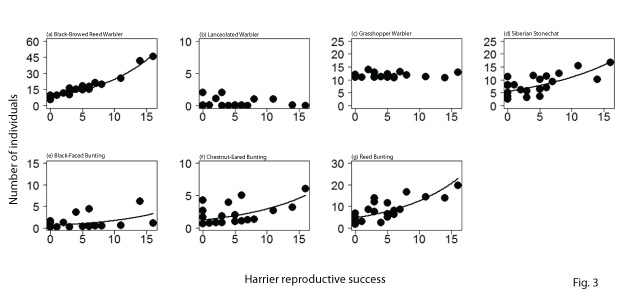Is Raptor Conservation Tied to the Conservation of Other Birds? —Fledgling Numbers Indicate a Link
Research Press Release | October 02, 2015
-
 Eastern marsh harrier (adult male): Total length approximately 50 cm. Listed as endangered on the Red List of the Ministry of the Environment. Lives throughout the year in wetlands and agricultural areas, and is a summer visitor in Hokkaido. In the Tomakomai region it makes nests in the reed beds of wetlands and raises young. It mainly eats animals of the rodent family.
Eastern marsh harrier (adult male): Total length approximately 50 cm. Listed as endangered on the Red List of the Ministry of the Environment. Lives throughout the year in wetlands and agricultural areas, and is a summer visitor in Hokkaido. In the Tomakomai region it makes nests in the reed beds of wetlands and raises young. It mainly eats animals of the rodent family. -
 Relationship between the parent populations of ten species of small birds, and harrier reproductive success: A higher value on the horizontal axis shows higher harrier reproductive success. Each black dot shows the abundance living per unit area in each wetland. The curves indicate that the population has a statistically significant relationship with harrier reproductive success.
Relationship between the parent populations of ten species of small birds, and harrier reproductive success: A higher value on the horizontal axis shows higher harrier reproductive success. Each black dot shows the abundance living per unit area in each wetland. The curves indicate that the population has a statistically significant relationship with harrier reproductive success. -
 Relationship between the number of fledglings of seven species of small birds, and harrier reproductive success: A higher value on the horizontal axis shows higher harrier reproductive success. Each black dot shows the population living per unit area in each wetland. The curves indicate that the abundance has a statistically significant relationship with harrier reproductive success. For the three species, the Siberian rubythroat, the long-tailed rosefinch, and the water rail, the abundances in the investigation were small, so analysis was not possible.
Relationship between the number of fledglings of seven species of small birds, and harrier reproductive success: A higher value on the horizontal axis shows higher harrier reproductive success. Each black dot shows the population living per unit area in each wetland. The curves indicate that the abundance has a statistically significant relationship with harrier reproductive success. For the three species, the Siberian rubythroat, the long-tailed rosefinch, and the water rail, the abundances in the investigation were small, so analysis was not possible.
| Press Release | ||
|---|---|---|
| Key Points | ・Regardless of the fact that raptor conservation is being recommended in many practical biodiversity conservation attempts, it has been unclear whether raptor conservation is tied to the maintenance of the abundance and reproductive success of other organisms.
・In the wetlands of the Tomakomai region of Hokkaido we investigated the relationship between the reproductive success (number of fledglings) of a raptor called the eastern marsh harrier, as well as the parent and fledgling abundances of other small birds. ・In wetlands with many harrier fledglings, the parent and fledgling abundances of other small birds is large. ・This research suggests that conservation based on the harrier reproductive success is useful to select high fecundity areas of other bird species. |
|
| Overview |
The conservation of raptor habitats is hypothesized to be related to the conservation of many other organisms, and raptor conservation is being performed in many locations worldwide. However, for a long time, it was unclear whether by using raptors as indicator species it was possible to conserve areas of high abundance and reproductive success of other organisms. In this research, in the wetlands of the Tomakomai region of Hokkaido, we measured the reproductive success (number of fledglings) of the eastern marsh harrier, a wetlands raptor, for three years. Then, we examined the parent and fledgling abundances of other small birds in wetlands that varied in harrier reproductive success. In the past, it was difficult to directly measure the reproductive success of small birds over wide areas, but we overcame this problem by developing a new method of luring not only the parents but also the fledglings, by using a loudspeaker to send out alarm calls of the small birds against predators. As a result, in wetlands where the number of harrier fledglings was high, we found that there were many parents and fledglings of several small bird species, and we successfully developed models that predict over a wide area the number of fledglings of small birds based on reproductive success of the harrier. These findings suggest that wetlands with high reproductive success of several sympatric small bird species could be conserved based on the reproductive success of the harrier. |
|
| Inquiries |
Futoshi NAKAMURA, Professor, Forest Ecosystem Management Group, Research Faculty of Agriculture, Hokkaido University TEL: +81-11-706-3343 FAX: +81-11-706-2517 E-mail:nakaf@for.agr.hokudai.ac.jp |
|
|
Japanese Link |
猛禽類の保全は他の鳥類の保全につながるか?巣立ち雛の数から迫る (2015.9.7) | |
| Publications | The usefulness of top predators as biodiversity surrogates indicated by the relationship between the reproductive outputs of raptors and other bird species, Biological Conservation (2015.8.14) | |
